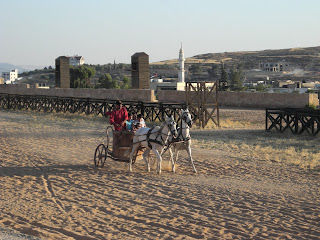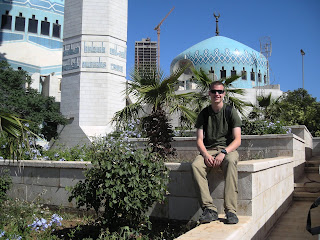One of our more colorful professors here at Yarmouk often states, with half-sarcasm and half-frustration: "Long vowels are not optional!" He does this because many times, when we read aloud, we make the mistake of not holding our long vowels (aa, uu, ee) long enough. Arabic has three long vowels (ا = aa, و = uu, and ي = ee), and three short vowels, which can sometimes be paired together with the long vowels to make other sounds (like oww, or ayy). Two of the long vowels (uu and ee) also double as consonants, depending on the surrounding letters. To add to the fun, the short vowels are not actually letters. Rather, they are special marks that are placed above and below the letters of a word (بَ = ba, بِ = bi, بُ = bu; ب is just the letter "b"). Now, to make it really interesting, most of the texts that are written do not contain the markings for short vowels, so you just need to know how to pronounce the word from the context of the other words.
This is hard.
So, it's no wonder that when we read aloud, we often stumble over our vowels, making our short a's long and vice versa. The problem is that sometimes the difference between two words can be as little as a short "a" or a long "aa." On Tuesday, I learned this lesson the hard way.
Our program director sent us several e-mails over the last few weeks listing the names of Jordanian students that wanted to form a sort of language partnership with us American students. The idea is that we would get together a few times a week for about and hour, and talk. While the Jordanian students helped us with our Arabic, we would help them with their English, so everybody wins.
I perused this list a few times, looking through the names to find a student to partner with. I was being a bit cautious because I learned that one of my fellow male students here accidently set up a meeting with a girl, which was a bit awkward, I'm told. After a couple looks, I found the name Anwar. Anwar is a safe bet, I told myself. After all, Anwar Sadat was a male. With this irrefutable logic, I e-mailed Anwar to set up time that we could meet. Anwar replied and we decided to meet Tuesday morning at the Language Center.
Turns out, Anwar is definitely a girl. Crap! Anwar Sadat was a man! How could this happen?!
I met with Anwar and one of her friends for about a half an hour, all the while wondering in my head if this was culturally inappropriate, and feeling a bit awkward. After we said goodbye, I went to my program director to tell him of my dilemma. Contrary to my concerns, he assured me that as long as it was fine with her (which it was), then it wasn't a problem. Well, that made me feel a bit better. At least I wasn't being culturally insensitive. After some internal debate, I decided to try and find a different language partner because I think it will be easier to befriend a male Jordanian. I also think conversation will be a bit easier without the awkward gender dynamic.
But, that decision still did not solve my initial mistake: how could Anwar Sadat be a male name, but Anwar be a female? I asked one of my other professors, "Is Anwar a male or a female name?" "It's a male name," he replied. Huh....I was completely baffled, but at least I felt a little bit better because my Jordanian professor also thought that Anwar was a male name. Well, at least I felt better until he said, "Yes, Anwar ( اَنوَر) is a male name, but Anwaar (اَنوار) is a girl's name."
Wow, I feel like an idiot! That little long vowel made all the difference, and at that moment, I heard my professor's voice screaming in my head: "LONG VOWELS ARE NOT OPTIONAL!!!!!"
This is hard.
So, it's no wonder that when we read aloud, we often stumble over our vowels, making our short a's long and vice versa. The problem is that sometimes the difference between two words can be as little as a short "a" or a long "aa." On Tuesday, I learned this lesson the hard way.
Our program director sent us several e-mails over the last few weeks listing the names of Jordanian students that wanted to form a sort of language partnership with us American students. The idea is that we would get together a few times a week for about and hour, and talk. While the Jordanian students helped us with our Arabic, we would help them with their English, so everybody wins.
I perused this list a few times, looking through the names to find a student to partner with. I was being a bit cautious because I learned that one of my fellow male students here accidently set up a meeting with a girl, which was a bit awkward, I'm told. After a couple looks, I found the name Anwar. Anwar is a safe bet, I told myself. After all, Anwar Sadat was a male. With this irrefutable logic, I e-mailed Anwar to set up time that we could meet. Anwar replied and we decided to meet Tuesday morning at the Language Center.
Turns out, Anwar is definitely a girl. Crap! Anwar Sadat was a man! How could this happen?!
I met with Anwar and one of her friends for about a half an hour, all the while wondering in my head if this was culturally inappropriate, and feeling a bit awkward. After we said goodbye, I went to my program director to tell him of my dilemma. Contrary to my concerns, he assured me that as long as it was fine with her (which it was), then it wasn't a problem. Well, that made me feel a bit better. At least I wasn't being culturally insensitive. After some internal debate, I decided to try and find a different language partner because I think it will be easier to befriend a male Jordanian. I also think conversation will be a bit easier without the awkward gender dynamic.
But, that decision still did not solve my initial mistake: how could Anwar Sadat be a male name, but Anwar be a female? I asked one of my other professors, "Is Anwar a male or a female name?" "It's a male name," he replied. Huh....I was completely baffled, but at least I felt a little bit better because my Jordanian professor also thought that Anwar was a male name. Well, at least I felt better until he said, "Yes, Anwar ( اَنوَر) is a male name, but Anwaar (اَنوار) is a girl's name."
Wow, I feel like an idiot! That little long vowel made all the difference, and at that moment, I heard my professor's voice screaming in my head: "LONG VOWELS ARE NOT OPTIONAL!!!!!"
























































